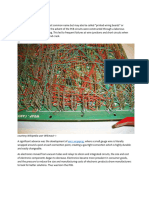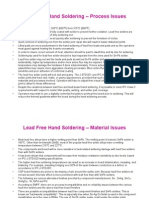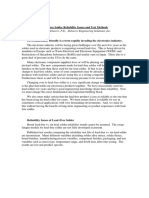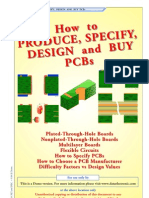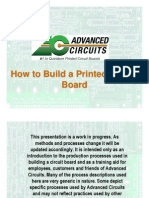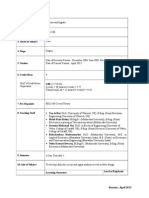Input Data: Component Code Value Description Footprint Code (Protel)
Input Data: Component Code Value Description Footprint Code (Protel)
Uploaded by
Alexis SanchezCopyright:
Available Formats
Input Data: Component Code Value Description Footprint Code (Protel)
Input Data: Component Code Value Description Footprint Code (Protel)
Uploaded by
Alexis SanchezOriginal Title
Copyright
Available Formats
Share this document
Did you find this document useful?
Is this content inappropriate?
Copyright:
Available Formats
Input Data: Component Code Value Description Footprint Code (Protel)
Input Data: Component Code Value Description Footprint Code (Protel)
Uploaded by
Alexis SanchezCopyright:
Available Formats
Input Data
Schematic diagram with component detail, interconnections, edge connector specification (refer to Appendix A-3 to A-6). Component list
Figure A-7 Component List Component code POWER SUPPLY BRIDGE1 R1 Z1 C1 C2 R2 Q1 C3 C4 R3 TRANSMITTOR BATTERY SW1 SW2 D1 D2 D3 D4 D5 SW3 U1 R4 LED1 R5 L2 VC1 C5 Value IN 4001 100 12V 220UF/16V O.1UF 33K 9013 1000UF/16V 47UF/16V 47K 12V Description Diode Resistor 1/4W Zener E Capacitor E Capacitor Resistor 1/4W Transistor E Capacitor E Capacitor Resistor 1/4W Battery Dip-switch Dip-switch Diode Diode Diode Diode Diode Dip-switch IC Resistor 1/4W LED 3mm Resistor 1/4W Coil Variable Capacitor Ceramic Capacitor Footprint Code (PROTEL) DIODE0.4 AXIAL0.4 DIODE0.4 AXIAL0.4 RB.2/.4 AXIAL0.4 T0-92A RB.2/.4 RB.2/.4 AXIAL0.4 AXIAL1.0 RAD0.2 RAD0.2 DIODE0.4 DIODE0.4 DIODE0.4 DIODE0.4 DIODE0.4 DIP8 DIP18 AXIAL0.4 RB.2/.4 AXIAL0.4 AXIAL0.4 AXIAL0.4 AXIAL0.4
IN 4148 IN 4148 IN4148 IN 4148 IN 4148 DIP-8 PT-2262 33M RED LED 18K 10UH 25P 3P
R6 Q2 R7 RECEIVER-UHF L3 VC2 C6 C10 R10 R12 C7 Q3 R11 C9 L4 R8 C8 R9 R7 R8 R9 R13 C11 R14 C12 R15 Z2 Z3 U2 R16 C13 R17 RECEIVERDECODER SW4 U3
47K MPSH10 100 1 TURN 5P 5P 100P 270 18K 3P MPSH10 33K 100n 8Turns 2.7K 330n 5.6K 100 2.7K 5.6K 18K 330n 6.8K 1UF/16V 120K 12V 12V MC4558 6.2M 2P 120K
Resistor 1/4W Transistor Resistor 1/4W Coil Variable Capacitor Ceramic Capacitor Ceramic Capacitor Resistor 1/4W Resistor 1/4W Ceramic Capacitor Transistor Resistor 1/4W Ceramic Capacitor Coil Resistor 1/4W Ceramic Capacitor Resistor 1/4W Resistor 1/4W Resistor 1/4W Resistor 1/4W Resistor 1/4W Ceramic Capacitor Resistor 1/4W E Capacitor Resistor 1/4W Zener Zener IC Resistor 1/4W Ceramic Capacitor Resistor 1/4W
AXIAL0.4 T0-92A AXIAL0.4 AXIAL0.4 AXIAL0.4 AXIAL0.4 AXIAL0.4 AXIAL0.4 AXIAL0.4 AXIAL0.4 T0-92A AXIAL0.4 AXIAL0.4 AXIAL0.4 AXIAL0.4 AXIAL0.4 AXIAL0.4 AXIAL0.4 AXIAL0.4 AXIAL0.4 AXIAL0.4 AXIAL0.4 AXIAL0.4 RB.2/.4 AXIAL0.4 DIODE0.4 DIODE0.4 DIP8 AXIAL0.4 AXIAL0.4 AXIAL0.4
DIP-8 PT-2272
Dip-switch IC
DIP8 DIP18
R18 R19 D6 U4 R20 Q4 LED2 R21 R22 RELAY1 CON1 D7 RELAY2 D8 Q5 C14
470K 20K IN 4148 MC14013 47K 9013 RED LED 4.7K 4.7K 12V 2-PIN IN 4148 12V IN 4148 9013 47UF/16V
Resistor 1/4W Resistor 1/4W Diode IC Resistor 1/4W Transistor LED 5mm Resistor 1/4W Resistor 1/4W Relay Socket Diode Relay Diode Transistor E Capacitor
AXIAL0.4 AXIAL0.4 DIODE0.4 DIP14 AXIAL0.4 T0-92A RB.2/.4 AXIAL0.4 AXIAL0.4 SIP8 SIP2 DIODE0.4 SIP8 DIODE0.4 T0-92A AXIAL0.4
mechanical specifications such as board size and shape, mounting holes, identification of restricted areas with respect to component height, edge connector PCB specifications, using single- and double-sided.
Photo Plotting
In the photo plotter, the input data are converted back to graphics by photographic (Refer to Appendix A-7 to A-9).
PCB Fabrication Process
Step 1 Clean the blank PCB. The first step is probably the most important. Step 2 Apply the Photoresist. While liquid photoresist can be applied by spraying, dipping, speed whirling, and roller coating, these methods are used primarily for mass-production in industry. When the liquid photoresist is first applied, it really is not yet a resist, but a sensitizer. To take on the properties of a resist that will protect copper underneath, it must be dried and exposed to ultraviolet light. Step 3 Dry the Photoresist and leave the board in a dark cabinet overnight to let it dry. Step 4 Expose the Sensitized PCB to Ultraviolet Light. If the board were now placed under an ultraviolet light, the entire sensitized surface would turn to a resist, and no copper could be etched away. Using an ultra-violet black light, set the printing frame so that it is directly facing the light, approximately 1 foot away. Be sure the surface is exposed to ultraviolet light and that the lamp holder does not cast shadows. Expose for a minimum of 2 minutes. When the exposure is complete, remote the PCB from the frame. The sensitized areas exposed to ultra-violet light are now hard and have formed into a resist. Step 5 Develop the Image (Pattern). The purpose of the developing step is to remove the unwanted remaining sensitized material (where there was no ultraviolet exposure) and bring out the latent image of the traces and pads. While still under safe-light condition, place the board in a tray filled to a depth of inch with developer. Cover the tray to avoid breathing harmful fumes, and rock the tray gently for about 20 minutes. Then, remove the board and let it drain. At this time return to normal lighting conditions. An image of the traces and pads should now be standing out in clear relief from the surrounding copper. Steps 6 Rinse and Dry. Under cool, slow running water, rinse the board for 2 t0 3 minutes. Do not let the water hit the board directly, since it could smear the resist pattern. Step 7 Of all the processes involved in making a PCB, the etching procedure is probably the easiest. Fill the etching container with acid to a depth that will cover the submerged PCB. Ideally, the board should be standing on edge. But if it must lie horizontally, be sure the copper side is facing up. Don't plunge the board into the acid; place it in the container.
Step 8 Using water to cleaning the Acid.
You might also like
- En. Zoom Meeting With Medical Doctors For Covid Ethics International - 20 Nov 2022Document5 pagesEn. Zoom Meeting With Medical Doctors For Covid Ethics International - 20 Nov 2022Jim Hoft100% (5)
- NGL ELT Imagine Sampler In5Document24 pagesNGL ELT Imagine Sampler In5PavoNo ratings yet
- What You Always Wanted To Know About Wave Soldering But Were Afraid To AskDocument43 pagesWhat You Always Wanted To Know About Wave Soldering But Were Afraid To Asksmtdrkd100% (4)
- Epec - Engineering Guide Flex and Rigid Flex PCBsDocument16 pagesEpec - Engineering Guide Flex and Rigid Flex PCBsAndrew P100% (1)
- PCB ManufacturerDocument12 pagesPCB ManufacturerPCB ManufacturerNo ratings yet
- IPC A 610DC Telecom AddendumDocument3 pagesIPC A 610DC Telecom Addendumfenriz666No ratings yet
- IPC/industry Standard of PCB and PCBA?: PCB Fabrication Steps: (Presentation-How-To-Build-Pcb)Document3 pagesIPC/industry Standard of PCB and PCBA?: PCB Fabrication Steps: (Presentation-How-To-Build-Pcb)HenryNo ratings yet
- PCB DesignDocument41 pagesPCB DesignvivNo ratings yet
- Workshop ManualDocument26 pagesWorkshop ManualHarender KumarNo ratings yet
- PCB (Printed Circuit Board) Designig: by ShubhamDocument15 pagesPCB (Printed Circuit Board) Designig: by Shubhamshubham SINGHNo ratings yet
- ASCEN SMT Conveyor List 0Document22 pagesASCEN SMT Conveyor List 0Igur EuiNo ratings yet
- Soldering 101: A Really TopicDocument24 pagesSoldering 101: A Really TopicGanesh ThakurNo ratings yet
- Reliability and Failure Mechanisms of Laminate Substrates in A Pb-Free WorldDocument13 pagesReliability and Failure Mechanisms of Laminate Substrates in A Pb-Free WorldHoong Chee ChungNo ratings yet
- Group 1 ElectronicsDocument24 pagesGroup 1 Electronicsjrsdelgado23No ratings yet
- Fjelstad 041609-Ee402sDocument99 pagesFjelstad 041609-Ee402sHoong Chee Chung100% (1)
- Lead Free Hand Soldering - Process and Material IssuesDocument3 pagesLead Free Hand Soldering - Process and Material Issuessmtdrkd50% (2)
- Wave Soldering: Wave Soldering Is A Bulk Soldering Process Used in TheDocument5 pagesWave Soldering: Wave Soldering Is A Bulk Soldering Process Used in TheMadhusudanan Ashok0% (1)
- Clear-Com RS-500 Series DatasheetDocument4 pagesClear-Com RS-500 Series DatasheetHenry PalNo ratings yet
- Ball Grid ArrayDocument29 pagesBall Grid ArrayyogeshleostarNo ratings yet
- Jedec Industry Standard Classifications and Peak Solder TemperatureDocument8 pagesJedec Industry Standard Classifications and Peak Solder TemperatureGuillermo VillarNo ratings yet
- Guidelines Surface Mount Technology SMT Soldering Application Note MelexisDocument62 pagesGuidelines Surface Mount Technology SMT Soldering Application Note Melexisengenhariatip1No ratings yet
- Electronics Industry: (Swot Analysis)Document12 pagesElectronics Industry: (Swot Analysis)santh87No ratings yet
- Mordax DATA - User Guide - 171002Document29 pagesMordax DATA - User Guide - 171002rustyNo ratings yet
- PackagingDocument38 pagesPackagingAmbrish TiwariNo ratings yet
- Tm12864h6ccwgwa1 G-1 (Wo PCB)Document32 pagesTm12864h6ccwgwa1 G-1 (Wo PCB)Feroz KhanNo ratings yet
- Printed Circuit BoardDocument23 pagesPrinted Circuit Boardahmed100% (2)
- ARTIGO - PCB Cross Section White PaperDocument3 pagesARTIGO - PCB Cross Section White PaperGuilherme Dos Santos MoreiraNo ratings yet
- M. Tech. Smart Manufacturing (SMT) : TheoryDocument7 pagesM. Tech. Smart Manufacturing (SMT) : TheoryselvakumarNo ratings yet
- Lead Free Solder Reliability Issues Test MethodsDocument7 pagesLead Free Solder Reliability Issues Test MethodsAntonio Vieira MScNo ratings yet
- PCB Surface Finishes Presentation by MultekDocument54 pagesPCB Surface Finishes Presentation by Multeksmtdrkd100% (1)
- PCB DesignDocument45 pagesPCB DesignkesavantNo ratings yet
- Gilleo Publications0108Document26 pagesGilleo Publications0108Arpit Gulati100% (1)
- Fundamentals of Board AssemblyDocument54 pagesFundamentals of Board AssemblyAmir AkmalNo ratings yet
- PCB Book v5.0.4 e Demo WDocument56 pagesPCB Book v5.0.4 e Demo Whlgc63100% (1)
- The Past, Present, and Future of IPC-A-610Document63 pagesThe Past, Present, and Future of IPC-A-610Jesus HolmesNo ratings yet
- Preparation of A National Environmentally Sound Management Plan For Pcbs and Pcb-Contaminated EquipmentDocument103 pagesPreparation of A National Environmentally Sound Management Plan For Pcbs and Pcb-Contaminated EquipmentYaredNo ratings yet
- SMT Solder Paste Printing Process Quality Improvement Through Six Sigma ApproachDocument30 pagesSMT Solder Paste Printing Process Quality Improvement Through Six Sigma ApproachAnonymous HizOWFNo ratings yet
- PCB Manufaturing Tutorial Pag 1Document44 pagesPCB Manufaturing Tutorial Pag 1FAUC)NNo ratings yet
- Types of PCB and Wave SolderingDocument4 pagesTypes of PCB and Wave Solderingpuranamravinder100% (2)
- 12-07-18-PCB Material Selection-46 SlidesDocument23 pages12-07-18-PCB Material Selection-46 SlidesShahrukh RafiNo ratings yet
- ch7 97 PDFDocument43 pagesch7 97 PDF剢断剑No ratings yet
- Reliable SMT Design: All There Is To KnowDocument100 pagesReliable SMT Design: All There Is To KnowMarcos Antonio De FariaNo ratings yet
- PCB DesignDocument26 pagesPCB DesignJomer JuanNo ratings yet
- What Is SMT Soldering Process Step by StepDocument12 pagesWhat Is SMT Soldering Process Step by StepjackNo ratings yet
- Ersa 2008Document26 pagesErsa 2008maxdan111No ratings yet
- Unit - III Basic Manufacturing Engineering Surface Mount Technology (SMT)Document5 pagesUnit - III Basic Manufacturing Engineering Surface Mount Technology (SMT)rooplalrana1636No ratings yet
- Understanding Bow and Twist On A PCBDocument12 pagesUnderstanding Bow and Twist On A PCBjackNo ratings yet
- Padslogic UserDocument1,012 pagesPadslogic Userruinam_engineeringNo ratings yet
- SMT Seminar ReportDocument26 pagesSMT Seminar ReportShruthi Uppar100% (1)
- Stencil Design For Mixed Technology through-holeSMDocument8 pagesStencil Design For Mixed Technology through-holeSMRobert MartosNo ratings yet
- CIT-131 Printed Circuit Board CIT-1 YearDocument14 pagesCIT-131 Printed Circuit Board CIT-1 YearNoumanNo ratings yet
- Comparison Education System Factory SystemDocument34 pagesComparison Education System Factory SystemWearayban MYNo ratings yet
- What Is Prepreg in PCBsDocument19 pagesWhat Is Prepreg in PCBsjackNo ratings yet
- Report Vishal Pandey LE 06Document26 pagesReport Vishal Pandey LE 06Baikunth PandeyNo ratings yet
- How To Solder The Chip ComponentsDocument19 pagesHow To Solder The Chip ComponentsjackNo ratings yet
- PCB Cti ValuesDocument4 pagesPCB Cti ValuesmadslayersNo ratings yet
- How Much Does It Cost To Manufacture A PCBDocument24 pagesHow Much Does It Cost To Manufacture A PCBjackNo ratings yet
- LEAN in The Lab 5Document17 pagesLEAN in The Lab 5asclswisconsinNo ratings yet
- Ehw ProjectDocument61 pagesEhw ProjectSiddhant Prakash GoyalNo ratings yet
- Vector DocumentationDocument10 pagesVector DocumentationAfonso MendesNo ratings yet
- Quasar Kit No. 1014 3-Channel Wireless Light Modulator: General DescriptionDocument5 pagesQuasar Kit No. 1014 3-Channel Wireless Light Modulator: General DescriptionAlbertNo ratings yet
- Acknowledgment: SHIVANSH KANSAL (1209099) VISHAL KAKKAR (1209121) VARUN HOODA (1209113)Document59 pagesAcknowledgment: SHIVANSH KANSAL (1209099) VISHAL KAKKAR (1209121) VARUN HOODA (1209113)Shivansh KansalNo ratings yet
- Holy Mother Novel PDF - Google PenelusuranDocument1 pageHoly Mother Novel PDF - Google Penelusuranmaryam unahartiNo ratings yet
- Steam TablesDocument3 pagesSteam Tableskimpatrick19No ratings yet
- Year 3 Science Plants Planning.198867045Document2 pagesYear 3 Science Plants Planning.198867045Riot ShadowNo ratings yet
- Explore The Concepts of Expectation, Standard Deviation, Variance, and CovarianceDocument33 pagesExplore The Concepts of Expectation, Standard Deviation, Variance, and CovarianceDhexter VillaNo ratings yet
- Using The DG4000 SpreadSheetDocument4 pagesUsing The DG4000 SpreadSheetRicardo IllaNo ratings yet
- The Social Sciences and The Humanities: - Use It Don't Lose ItDocument32 pagesThe Social Sciences and The Humanities: - Use It Don't Lose ItJuan David MesaNo ratings yet
- Cement Test Report: National Technical Manager Hanson CementDocument1 pageCement Test Report: National Technical Manager Hanson Cementnickdash09No ratings yet
- Unit 1 IOTDocument125 pagesUnit 1 IOTnagamalleswari2010No ratings yet
- ACI 211.1 Study ExampleDocument20 pagesACI 211.1 Study ExampleSinan İcik100% (1)
- Bizhub 215 BroshureDocument4 pagesBizhub 215 BroshureionutkokNo ratings yet
- Contrast Control For ILFORD MULTIGRADEDocument4 pagesContrast Control For ILFORD MULTIGRADEJuan Fco MartínNo ratings yet
- SBA Group Assignment - Anara Bhisma Soca DriyaDocument32 pagesSBA Group Assignment - Anara Bhisma Soca DriyaAnara BhismaNo ratings yet
- Em Swedenborg The Economy of The Animal Kingdom 1740 1741 Two Volumes Augustus Clissold 1845 1847 The Swedenborg Scientific Association 1955 First PagesDocument338 pagesEm Swedenborg The Economy of The Animal Kingdom 1740 1741 Two Volumes Augustus Clissold 1845 1847 The Swedenborg Scientific Association 1955 First Pagesfrancis batt100% (1)
- Sibelius Tutorials - APOSTILADocument135 pagesSibelius Tutorials - APOSTILAJorge NobreNo ratings yet
- Equivalent Expressions No AnswersDocument7 pagesEquivalent Expressions No Answersicynitrogen9087No ratings yet
- EEL2186 Circuits and Signals SyllabusDocument4 pagesEEL2186 Circuits and Signals SyllabusSasitaran BaskaranNo ratings yet
- Sociology (Lib420) Topic 1Document48 pagesSociology (Lib420) Topic 1Fahmi Ab RahmanNo ratings yet
- Time Implication For Jinka Town RoadDocument2 pagesTime Implication For Jinka Town RoadTewodros TadesseNo ratings yet
- Teori MotivasiDocument2 pagesTeori MotivasiAndrianus AtuNo ratings yet
- CREW v. EOP: Regarding Missing WH Emails: 8/15/08 - EOP's Objection To Report and IonsDocument141 pagesCREW v. EOP: Regarding Missing WH Emails: 8/15/08 - EOP's Objection To Report and IonsCREWNo ratings yet
- Survey On Helical AntennaDocument22 pagesSurvey On Helical AntennaShiva MetikalaNo ratings yet
- The Palgrave Handbook of Supply Chain Management Joseph Sarkis All Chapters Instant DownloadDocument32 pagesThe Palgrave Handbook of Supply Chain Management Joseph Sarkis All Chapters Instant Downloadtuenadesna100% (14)
- Slump Test Report PMMDocument7 pagesSlump Test Report PMMLuqman Yusof83% (12)
- Organizational Behavior - Exam Focus With Answers-NewDocument14 pagesOrganizational Behavior - Exam Focus With Answers-Newaydinmurad100% (2)
- Azizi Anas - MEC551 - Assignment - 1 CHAPTER 1 To 3 - May 2020Document2 pagesAzizi Anas - MEC551 - Assignment - 1 CHAPTER 1 To 3 - May 2020Azizi AnasNo ratings yet
- 2nd QTR - Week 1 ActivityDocument5 pages2nd QTR - Week 1 ActivityMelvs Tzy100% (1)
- OrderFlow Charts and Notes 09th Oct 17 - VtrenderDocument8 pagesOrderFlow Charts and Notes 09th Oct 17 - VtrenderSinghRaviNo ratings yet
- Membuat Reagen Kimia Di LaboratoriumpdfDocument13 pagesMembuat Reagen Kimia Di LaboratoriumpdfMuhammad ToriNo ratings yet







